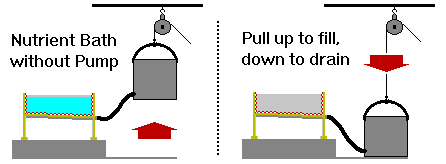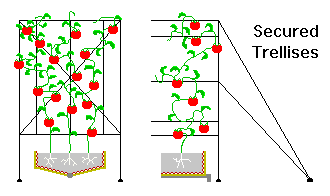
 Your Own Gardens
Your Own Gardens
- Crops are grown in beds which are really shallow tanks or troughs that serve as a container for
gravel or coarse sand. If there are several of these beds, they should be set up in a series at the same level
and of a similar size.
- These beds should be about 3 feet wide and any convenient length, although 100 feet is
common. The sides are about 8 inches high and with a V bottom so the center is 11 or 12 inches deep at
the center.
- Beds intended to survive massive earthquake damage should be wooden frames lined with
heavy vinyl sheeting. Pipes or other fittings should be plastic for increased flexibility and ease of repair
after earthquake damage.

- This permits an arrangement whereby a half-tile or similar device through the center of the bed
will feed or drain the solution rapidly from one end of the bed to the other. It is very important that the
slope be precise, with no low areas from which solution will not drain.
- Drainage in the beds is not only pointed toward the V bottom of the bed, but also toward one
end of the bed, so that the V at the drain end is 2" lower than at the high end of the bed. This is a slight
slope in the bottom of the trough.

- There must be a pipe connection to the lowest point in the V at the drain end of the trough.
The nutrient solution can then be pumped into the trough through that pipe and will drain out again when
the pump has been shut off. The quantity of solution in the tank should be just sufficient to bring the
water level up to within 1/2 to 1 inch of the top of the gravel or sand in the beds.
- The entire hydroponics system is relatively simple to operate and may be made at least semi-
automatic. In cool weather, pumping solution should be done once a day, but in warm, dry, or windy
weather, it may be necessary 2 or 3 times a day. Installation of a time clock allows the start and stop of
the pump to be automatically.
- A centrifugal pump of sufficient capacity to fill beds in one-half hour is generally best for
forcing the solution into the beds. With a centrifugal pump, the solution will flow by gravity through the
pump back into the tank.

- For those without a pump, a simple pail and flexible hose system to give the hydroponic beds
their daily nutrient bath works well.

- Gravel for the bed should be fairly uniform in texture, about 1/2 to 1/4 in diameter, and
washed. If you use sand, it should be coarse and it also should be washed. Beds should be filled to within
1 inch of the top. The mix should be sterilized with heat or steam to prevent mildew and fungus
problems.
- Use the best seed for seedlings, planted in disease-free soil or sand and six inches or more high
before transplanting. Loosen the planting media around the roots so that there will be as little injury as
possible to the roots during transplanting. Rinse the planting media off the roots with water before
planting in the hydroponic beds.
- Supporting structures may be necessary to hold up the plants, as plants loaded with fruit, for
example, are heavy. Do not attach supports to the ends of beds because the weight of the plants may warp
the structure and cause leaks or draining problems. All supporting wires are suspended from overhead
supports that are spaced at intervals alongside the troughs.

- Cooling of the hydroponic area can be achieved by ventilation, as transpiration of moisture off
the leave cools the plants just as perspiration cools the human body. Slats or windows that allow the air to
circulate should be included in the arrangement.
- Plants produce oxygen during the day, under lighted conditions, and carbon dioxide during the
night. Hydroponic areas attached to living areas thus can oxygenate and cleanse the air of carbon dioxide,
but should be closed off during the night so that oxygen is not depleted from the sleeping areas.
- Pollination can be done either by bees or by hand, by manually shaking or tapping the flowers
once a day, going flower to flower so as to spread the pollen. Pollination helps increase fruit
yield, and for some produce makes the difference between a high yield or no yield at all.
Authored by Nancy.



![]()




